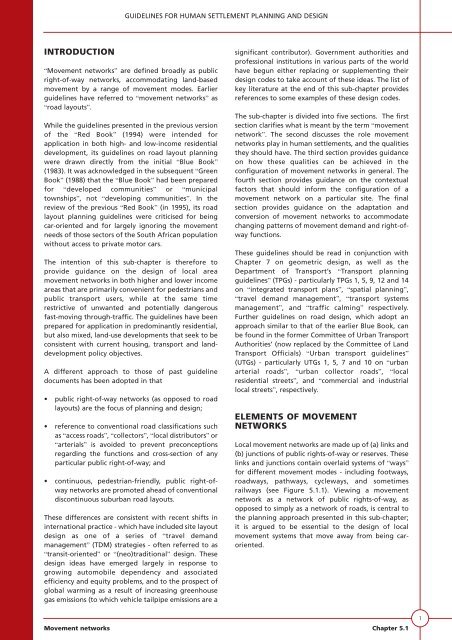VOLUME 1 HUMAN SETTLEMENT PLANNING AND ... - CSIR
VOLUME 1 HUMAN SETTLEMENT PLANNING AND ... - CSIR
VOLUME 1 HUMAN SETTLEMENT PLANNING AND ... - CSIR
- No tags were found...
You also want an ePaper? Increase the reach of your titles
YUMPU automatically turns print PDFs into web optimized ePapers that Google loves.
GUIDELINES FOR <strong>HUMAN</strong> <strong>SETTLEMENT</strong> <strong>PLANNING</strong> <strong>AND</strong> DESIGNINTRODUCTION“Movement networks” are defined broadly as publicright-of-way networks, accommodating land-basedmovement by a range of movement modes. Earlierguidelines have referred to “movement networks” as“road layouts”.While the guidelines presented in the previous versionof the “Red Book” (1994) were intended forapplication in both high- and low-income residentialdevelopment, its guidelines on road layout planningwere drawn directly from the initial “Blue Book”(1983). It was acknowledged in the subsequent “GreenBook” (1988) that the “Blue Book” had been preparedfor “developed communities” or “municipaltownships”, not “developing communities”. In thereview of the previous “Red Book” (in 1995), its roadlayout planning guidelines were criticised for beingcar-oriented and for largely ignoring the movementneeds of those sectors of the South African populationwithout access to private motor cars.The intention of this sub-chapter is therefore toprovide guidance on the design of local areamovement networks in both higher and lower incomeareas that are primarily convenient for pedestrians andpublic transport users, while at the same timerestrictive of unwanted and potentially dangerousfast-moving through-traffic. The guidelines have beenprepared for application in predominantly residential,but also mixed, land-use developments that seek to beconsistent with current housing, transport and landdevelopmentpolicy objectives.A different approach to those of past guidelinedocuments has been adopted in that• public right-of-way networks (as opposed to roadlayouts) are the focus of planning and design;• reference to conventional road classifications suchas “access roads”, “collectors”, “local distributors” or“arterials” is avoided to prevent preconceptionsregarding the functions and cross-section of anyparticular public right-of-way; and• continuous, pedestrian-friendly, public right-ofwaynetworks are promoted ahead of conventionaldiscontinuous suburban road layouts.These differences are consistent with recent shifts ininternational practice - which have included site layoutdesign as one of a series of “travel demandmanagement” (TDM) strategies - often referred to as“transit-oriented” or “(neo)traditional” design. Thesedesign ideas have emerged largely in response togrowing automobile dependency and associatedefficiency and equity problems, and to the prospect ofglobal warming as a result of increasing greenhousegas emissions (to which vehicle tailpipe emissions are asignificant contributor). Government authorities andprofessional institutions in various parts of the worldhave begun either replacing or supplementing theirdesign codes to take account of these ideas. The list ofkey literature at the end of this sub-chapter providesreferences to some examples of these design codes.The sub-chapter is divided into five sections. The firstsection clarifies what is meant by the term “movementnetwork”. The second discusses the role movementnetworks play in human settlements, and the qualitiesthey should have. The third section provides guidanceon how these qualities can be achieved in theconfiguration of movement networks in general. Thefourth section provides guidance on the contextualfactors that should inform the configuration of amovement network on a particular site. The finalsection provides guidance on the adaptation andconversion of movement networks to accommodatechanging patterns of movement demand and right-ofwayfunctions.These guidelines should be read in conjunction withChapter 7 on geometric design, as well as theDepartment of Transport’s “Transport planningguidelines” (TPGs) - particularly TPGs 1, 5, 9, 12 and 14on “integrated transport plans”, “spatial planning”,“travel demand management”, “transport systemsmanagement”, and “traffic calming” respectively.Further guidelines on road design, which adopt anapproach similar to that of the earlier Blue Book, canbe found in the former Committee of Urban TransportAuthorities’ (now replaced by the Committee of LandTransport Officials) “Urban transport guidelines”(UTGs) - particularly UTGs 1, 5, 7 and 10 on “urbanarterial roads”, “urban collector roads”, “localresidential streets”, and “commercial and industriallocal streets”, respectively.ELEMENTS OF MOVEMENTNETWORKSLocal movement networks are made up of (a) links and(b) junctions of public rights-of-way or reserves. Theselinks and junctions contain overlaid systems of “ways”for different movement modes - including footways,roadways, pathways, cycleways, and sometimesrailways (see Figure 5.1.1). Viewing a movementnetwork as a network of public rights-of-way, asopposed to simply as a network of roads, is central tothe planning approach presented in this sub-chapter;it is argued to be essential to the design of localmovement systems that move away from being caroriented.Movement networks Chapter 5.11
















